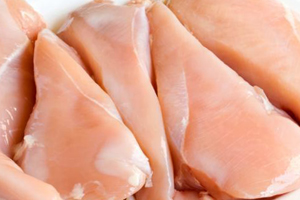Research: White striping on commercial poultry meat

Researchers in Italy looked at the occurrence of white striping under commercial conditions and its impact on breast meat quality in broiler chickens.
The growing demand for poultry meat has resulted in pressure on breeders, nutritionists and growers to increase the growth rate of birds, to increase feed efficiency and to increase the size of the breast muscle and to reduce abdominal fat.
Today chickens and turkeys are marketed at about half the time and twice the market weight, compared to the situation 50 years ago, at a lower cost of production. Rapid growing birds, however, have shown an increasing incidence of breast muscle abnormalities. Current concerns regarding poultry meat quality focus on deep pectoral muscle disease and white striping, both have negative effects on product appearance and suitability of the products for further processing.
White striping defect is a relative new quality issue and can be best described as white striation on the surface of pectoralis major muscles. The cause of white striping is not known, but histological examinations showed a connection with muscle degeneration and myopathic changes.
In this study the incidence of white striping in commercial meat type broiler strains, reared and processed under commercial conditions was investigated. The meat quality characteristics of breast fillets which showed white striping were determined.
The first experiment was to estimate the level of white striping in the processing plant. 500 Fillets from 56 flocks were examined during a 4 month period in a commercial slaughterhouse. Birds were slaughtered at 45 to 54 days of age and the average live weight was 2,75 kg. Classification was done in three categories, normal, moderate and severe white striping. In total 12% of the samples showed moderate (8,9%) or severe (3,1%) signs of white striping. A higher incidence was found in fillets from birds selected for high breast yield.
In the second experiment 153 breast fillets from 7 week old birds, average live weight 2,8 kg, were collected and classified for normal, moderate or severe white striping. pH, colour, cook loss, total yield, shear force values after marinating were estimated. Severe fillets showed higher pH values, also a lower marinade uptake was noticed. Cook losses increased in the severe white striping group and shear force values decreased. It was clearly demonstrated that the occurrence of white striping in breast fillets resulted in broiler meat with negative impact on water holding and binding capacity of the breast meat.
(M. Petracci, S. Mudalal, A, Bonfiglio and C. Cavani, Poultry Science 92, 1670-1675)













